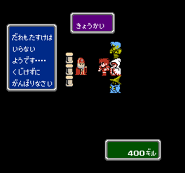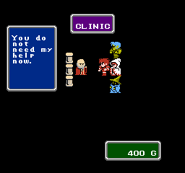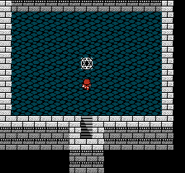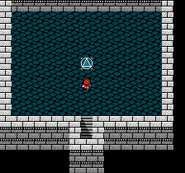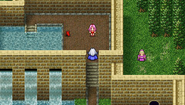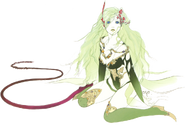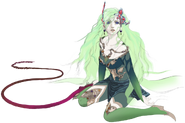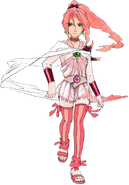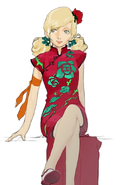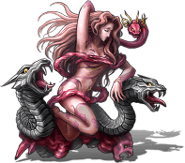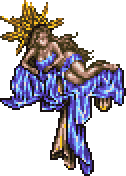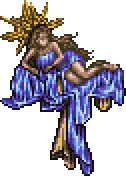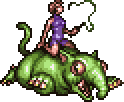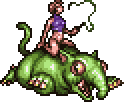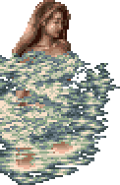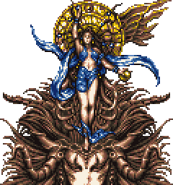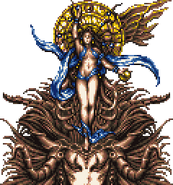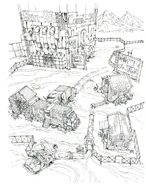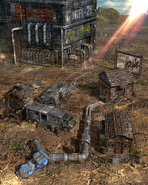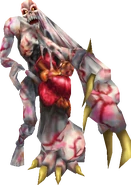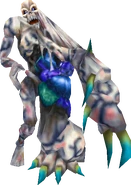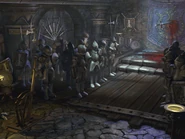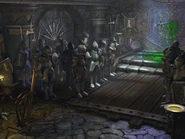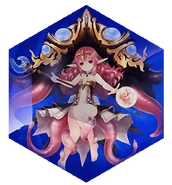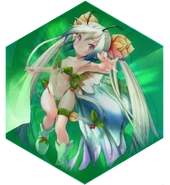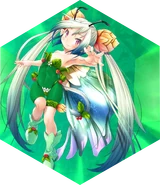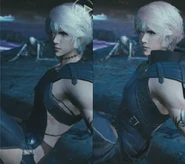
A "censor" screen added for humor when using Devour in Final Fantasy VIII.
Censorship refers to the suppression of material that may be considered objectionable, harmful, sensitive, politically incorrect or inconvenient as determined by governments, media outlets, authorities or other groups or institutions. In video games, things are sometimes censored due to ratings concerns. The Final Fantasy series games have seen some changes from their original versions due to sensitivities towards profanity, religious imagery, sexual imagery and violence and gory content.
Appearances
Final Fantasy
Template:Sideicon The 1990 North American localization was essentially identical to the original Japanese game. Technical limitations, and the censorship policies of Nintendo of America, resulted in a few minor changes to certain elements, however. Nintendo of America policy prohibited games from featuring any overt Judeo-Christian imagery or reference to death. Some graphics were modified so that, for instance, churches, renamed "clinics", no longer featured crosses. This is also probably why the Kill spell was renamed as "Rub".
Final Fantasy II
Template:Sideicon Following the successful release of the original Final Fantasy by Nintendo in 1990, Square Soft, Square's North American subsidiary, began work on an English language localization of Final Fantasy II. Although a beta version was produced, and the game was advertised in several Square Soft trade publications, the age of the original Japanese game and the arrival of the Super Nintendo Entertainment System, the NES's successor console, led Square Soft to cancel work on the Final Fantasy II localization in favor of the recently released Final Fantasy IV (which, to avoid confusing North American gamers, was retitled Final Fantasy II).
Even at the prototype stage changes had been made from the original version due to the religious imagery policies Nintendo had at the time: The Star of David used in a dungeon design was replaced with a triangle, and the cross that replaces a character's face on the pause screen at death was replaced with a gravestone.
Final Fantasy IV
Template:Sideicon In one cutscene in the original version, Rosa is rescued at the last moment from being executed by a giant scythe. The scythe was replaced with a giant metal ball in the North American version. Religious imagery was removed, such as "Holy" being renamed "White" (though one use of the word "Holy" was used by the Elder of Mysidia as he instructs Cecil on how to be a Paladin). The Tower of Prayers in Mysidia was renamed the Tower of Wishes (though one instance of "pray" was still left in, uttered by the Black Mage in the tower). Textual edits removed references to death and violence, partially to adhere to Nintendo's family friendly content guidelines.
In the original Japanese SNES release, the dancing dirl that appears in pubs removes her red dress to reveal a bikini underneath before dancing and getting dressed again. The segment of her undressing was censored out of the original North American release. It was restored in the Game Boy Advance release, but was again censored in the North American and European version for the PlayStation Portable.
Final Fantasy IV: The After Years
Template:Sideicon The artworks of Rydia, Porom, and Ursula have been altered to be less revealing for the overseas releases.
Final Fantasy V
Template:Sideicon
The sprite of the boss Melusine was changed for the remastered version, depicting her with the less revealing clothes seen in Amano's artwork .
.
Final Fantasy VI
Template:Sideicon Template:PseudoImage In the original North American SNES version the spell Holy was renamed "Pearl", the summon "Jihad" was renamed to "Crusader", and Hell's Rider to "Rider". Many sprites were also censored. Overly revealing sprites, such as Siren, Lakshmi (Starlet), Alluring Rider (Critic), Chadarnook (woman), Goddess, Power (Hit), Magic, Lady (Girl), and another untargettable part on the final boss, were censored. The smoke for Misty and her palette-swaps were removed. Pub signs were changed to cafe signs. The PlayStation version uses all uncensored sprites from the original Japanese release. Siren sprite was re-censored in the localized GBA versions, but not as much as in the SNES release. Chadarnook Goddess sprite was also re-censored for the localized GBA, censoring the same areas but is not the same as the SNES sprite.
During the scene where Locke sees Celes imprisoned in South Figaro, she is no longer being beaten by the guards in the GBA version, and they merely taunt her. The censoring of Celes's beating isn't from the localization; this was also present in the Japanese Advance version. The scene where Celes is being tortured by the Gestahlian Empire was removed because the original Final Fantasy VI was created before the Japanese ratings board, CERO, existed. Violence is rated strictly in Japan, and Square wanted a CERO A rating for the Game Boy Advance version, which would have been impossible if a game depicts violence against a restrained human.[1]
The conversation between Edgar and Relm during their first meeting in Thamasa was censored. In the Japanese version, after Edgar learned about Relm's age (10), he said to himself: "I need to get a hold of myself.... or it's going to be a crime". In the English versions, Edgar says: "Not even a lady yet. Here's hoping you're still around in eight years, kid".
Final Fantasy VII
Template:Sideicon Final Fantasy VII employs some self-censorship. The concept art for Corel Prison shows the billboard for Shinra Electric Power Company spray-painted over with the word "Fuck". In the final game, the word is further painted over turning it into "Pyck". The brothel Honey Bee Inn also initially had more content, but these were removed early, their remains only existing as dummied content in the original Japanese version.
Cloud Strife, Cid Highwind and Barret Wallace's use of the word "shit" and Tifa Lockhart's use of the word "Wench" was censored for the PC version, turning it into symbols, although one instance of it was missed: if the player examines the blue lights in the Forgotten Capital with Cid as party leader, his reaction still uses the word even in the PC versions.
Crisis Core -Final Fantasy VII-
Template:Sideicon The Minerva statue seen in the Banora Underground was redesigned from the Japanese version for its English release, as the original model was deemed to resemble depictions of the Virgin Mary.
Final Fantasy VIII
Template:Sideicon In the original Japanese version, the boss Gerogero's organs were red. The change to blue for the localized versions was probably made because the red makes the organs protruding from the creature look far more real. The red version of Gerogero can also be seen in both the BradyGames and Piggyback Interactive official strategy guides for Final Fantasy VIII.
The Ultimecia Castle's armory originally had red blood on the wall, but in the localized versions it has turned green.
The weapon Selphie wields is called nunchaku in the NTSC versions and "shinobou" in the PAL version, due to nunchaku's status as an illegal weapon in the UK.
When the player uses the Devour command they get a "Censored...please stand by" message while eating sounds play on the background. Nothing is actually censored; the scene is in every version of the game and is included for humor.
Final Fantasy XII
Template:Sideicon

The scene where Penelo is held hostage is censored from the Japanese version.
The scene where Penelo is tied up in Ba'Gamnan's Lhusu Mines hideout was cut from the original Japanese version of the game to get a lower rating. Producer Akitoshi Kawazu has explained the decision to do this thusly: "[...] at the time right before the Japanese release there were various incidents in the real world which...basically there were some similarities there that would have made it a difficult thing to release at the lower age rating that we wanted."[2]
This is a rare case of a Final Fantasy game being censored for Japan, but not for overseas versions. The "incidents in the real world" Kawazu refers to, but does not specify, may refer to Tsutomu Miyazaki, a Japanese serial killer who abducted and murdered four young girls in Saitama and Tokyo Prefectures from August 1988 to June 1989. His death sentence was upheld by the Japanese supreme court in January 2006, two months before Final Fantasy XII came out.
Final Fantasy XV
Template:Sideicon
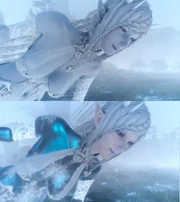
Comparison of the Shiva models.
The Chinese version has an altered model for Shiva with a skin-tight shiny outfit rather than appearing almost nude, and less pale skin.
Early material for Final Fantasy Versus XIII had the kingdom of Lucis worship the Grim Reaper more prominently. This was toned down when the game became Final Fantasy XV due to ratings concerns in certain countries.
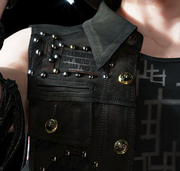
Close-up of Prompto's vest.
Prompto Argentum's vest had a tag that read "It's a beautiful day now watch some bastard fuck it up" in the earlier renders for his character, and in the Final Fantasy XV Episode Duscae demo. This is an actual tag available from the clothing company Roen that collaborated to design the main cast's outfits for the game. In the final game the message is changed to "It's a beautiful day now watch some bastard mess it up."
The Chadarnook enemy is based on the enemy of the same name from Final Fantasy VI, and is largely similar in appearance as a nude woman with clouds covering her privates. It is the target of a quest from Vyv Dorden, who tasks the party with photographing the famous daemon for his magazine. When he receives the photograph, he remarks that the picture is too risqué for his magazine, lampshading the enemy's previous censorship in VI.
In the Bestiary, the 3D models of Shiva, Chadarnook and Melusine are locked from free-rotation, unlike other creature models.
Final Fantasy Type-0
Template:Sideicon In the HD version, Kazusa's swimsuit model and Emina's lingerie model were removed from the Historical Personae. They were viewable as alternate outfits in the Rubicus after completing the characters' sidequests in the PlayStation Portable version.
Final Fantasy Tactics
Template:Sideicon The final battle with Wiegraf Folles is different depending on the version played. Ramza Beoulve and Wiegraf converse numerous times, but a line that is missing in Final Fantasy Tactics: War of the Lions port is Wiegraf stating how religion is perceived in the world in response to Ramza calling him a hypocrite for taking the sides that he has. This was likely removed as it might be offensive to people in the newer version.
Final Fantasy Tactics Advance
Template:Sideicon In the Japanese version, a scene at the beginning of the game was modified for the English release. In real life, the death of his wife, Remedi, caused Cid to fall into a drunk stupor. His depression was downplayed in the English version of the game, where Mewt and his friends catch him cringing before his superiors at work.
Final Fantasy Mystic Quest
Template:Sideicon The Holy spell was censored to White.
Final Fantasy Adventure
Template:Sideicon The magic circle in Wendel was a hexagram (Star of David) in the original Japanese version. It was changed to an octagram for the North American and European versions. Also, Sumo and Amanda were looking for Medusa's blood, not her tears.
The Final Fantasy Legend
Template:Sideicon God was changed to Creator due to the Video Game Content Guidelines set by Nintendo of America.
Final Fantasy Legend II
Template:Sideicon On Edo World, the bananas mentioned in the story were originally opium in the Japanese version.
Final Fantasy Legend III
Template:Sideicon The word Holy was censored to White; this affects the white magic Holy and the Holy Lance. The Holy Swords were renamed to Mystic Swords.
Bravely Default
Template:Sideicon The western release has been modified with characters' outfits made less revealing and some outfits being completely removed from the game. Some characters have been aged a couple years compared to the Japanese game.
Bravely Second: End Layer
Template:Sideicon The character Aimee Matchlock who has a Native American-themed job class and outfit, had her job title and outfit altered to a cowboy theme in the overseas releases. Magnolia Arch's Planeswarden Garb had a white line placed through the outfit's slit in the overseas releases. Bonsoir Bunny and Bravo Bunny's stomach holes were filled in and the thighs were covered. The Eastern War Garb's bottom half was covered up with a toga.
Final Fantasy Dimensions II
Template:Sideicon The Signet artworks for many female summons have been altered to be less revealing in the localization of Final Fantasy Dimensions II. Examples include Sylph's default appearance being changed into a leotard and stockings being added to the Mind Flayer summon.
Mobius Final Fantasy
Template:Sideicon Wol was designed with a lightweight costume for his initial "Onion Knight" gear, seeing that it was intended as a "bare bones" job. In response to player feedback, however, the design was changed to cover up more.[3]
References
Template:Recurring elements

